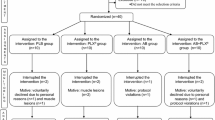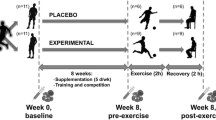Summary
Background
Exhaustive exercise induces oxidative stress. The cellular antioxidant defence systems have demonstrated great adaptation to chronic exercise.
Aim
To establish the influence of the antioxidant diet supplementation on the erythrocyte and lymphocyte antioxidant enzyme activities in athletes at basal and post–exercise levels.
Methods
Fifteen amateur trained male athletes were randomly distributed in two groups: control and antioxidant supplemented (90 days’ diet supplementation with 500 mg/day vitamin E and 30 mg/day β–carotene, and the last 15 days also with 1 g/day vitamin C). The study was double blind. Maximal and submaximal exercise tests were performed after three months of diet supplementation. The study was developed during the training and competition season.
Results
The sportsmen of the supplemented group presented significantly higher plasmatic final levels of vitamin C, vitamin E and β–carotene. Erythrocyte glutathione reductase activity significantly decreased in the placebo group but was maintained in the supplemented group after the three months studied. The erythrocyte superoxide dismutase activity increased after the training/competition period in the placebo group. Lymphocyte catalase and glutathione peroxidase activities increased significantly in the supplemented group after the supplementation period but were maintained in the placebo group. No effects of the antioxidant supplementation were observed in the erythrocyte antioxidant enzyme response to the exercise tests. The antioxidant supplementation induced a better adaptation of lymphocyte catalase after submaximal test.
Conclusions
Lymphocytes showed higher sensibility to antioxidant supplementation, improving the response of antioxidant enzymes to training and to acute exercise. In erythrocytes the training adaptations were more important than the antioxidant supplementation effects.
Similar content being viewed by others
References
Nieman DC (1994) Exercise, upper respiratory tract infection, and the immune system. Med Sci Sports Exerc 26:128–139
Petersen EW, Ostrowski K, Ibfelt T, Richelle M, Offord E, Halkjaer-Kristensen J, Pedersen BK (2001) Effect of vitamin supplementation on cytokine response and on muscle damage after strenuous exercise. Am J Physiol Cell Physiol 280:C1570–C1575
Suzuki K, Totsuka M, Nakaji S, Yamada M, Kudoh S, Liu Q, Sugawara K, Yamaya K, Sato K (1999) Endurance exercise causes interaction among stress hormones, cytokines, neutrophil dynamics, and muscle damage. J Appl Physiol 87:1360–1367
Cannon J, Blumberg J (2000) Acute phase immune response in exercise. In: Sen CK PL, Hänninen O (eds) Handbook of Antioxidants and Antioxidants in Exercise. Elsevier Science, Amsterdam, pp 177–194
Tauler P, Aguilo A, Cases N, Sureda A, Gimenez F, Villa G, Cordova A, Biescas AP (2002) Acute phase immune response to exercise coexists with decreased neutrophil antioxidant enzyme defences. Free Radic Res 36:1101–1107
Shek PN, Shephard RJ (1998) Physical exercise as a human model of limited inflammatory response. Can J Physiol Pharmacol 76:589–597
Castell LM, Poortmans JR, Leclercq R, Brasseur M, Duchateau J, Newsholme EA (1997) Some aspects of the acute phase response after a marathon race, and the effects of glutamine supplementation. Eur J Appl Physiol Occup Physiol 75:47–53
Krause R, Patruta S, Daxbock F, Fladerer P, Biegelmayer C, Wenisch C (2001) Effect of vitamin C on neutrophil function after high-intensity exercise. Eur J Clin Invest 31:258–263
Lenton KJ, Therriault H, Fulop T, Payette H, Wagner JR (1999) Glutathione and ascorbate are negatively correlated with oxidative DNA damage in human lymphocytes. Carcinogenesis 20:607–613
Powers SK, Sen CK (2000) Physiological antioxidants and exercise training. In: Sen CK PL, Hänninen O (eds) Handbook of antioxidants and antioxidants in Exercise. Elsevier Science, Amsterdam, pp 221–242
Selamoglu S, Turgay F, Kayatekin BM, Gonenc S, Yslegen C (2000) Aerobic and anaerobic training effects on the antioxidant enzymes of the blood. Acta Physiol Hung 87:267–273
Ohno H, Yahata T, Sato Y, Yamamura K, Taniguchi N (1988) Physical training and fasting erythrocyte activities of free radical scavenging enzyme systems in sedentary men. Eur J Appl Physiol Occup Physiol 57:173–176
Robertson JD, Maughan RJ, Duthie GG, Morrice PC (1991) Increased blood antioxidant systems of runners in response to training load. Clin Sci (Lond) 80:611–618
Tauler P, Gimeno I, Aguilo A, Guix MP, Pons A (1999) Regulation of erythrocyte antioxidant enzyme activities in athletes during competition and shortterm recovery. Pflugers Arch 438: 782–787
Tauler P, Aguilo A, Fuentespina E, Tur JA, Pons A (2002) Diet supplementation with vitamin E, vitamin C and betacarotene cocktail enhances basal neutrophil antioxidant enzymes in athletes. Pflugers Arch 443:791–797
Boyum A (1964) Separation of white blood cells. Nature 204:793–794
Parera M, Guix P, Pérez G, Quetglas P, Fuentespina E, Llompart I (1996) Estudio del error aleatorio en distintos parámetros de rutina bioquímica en el autoanalizador DAX-78. Quim Clin 15: 232–239
Aebi HE (1984) Catalase. In: Bergmeyer HU (ed) Methods in Enzymatic Analysis. Verlag Chemie, Basel, pp 273–286
Goldberg DM, Spooner RJ (1985) Glutathione Reductase. In: Bergmeyer HU (ed) Methods in Enzymatic Analysis. Verlag Chemie, Basel, pp 258–265
Flohe L, Gunzler WA (1984) Assays of glutathione peroxidase. Methods Enzymol 105:114–121
McCord JM, Fridovich I (1969) Superoxide dismutase. An enzymic function for erythrocuprein (hemocuprein). J Biol Chem 244:6049–6055
Hess D, Keller HE, Oberlin B, Bonfanti R, Schuep W (1991) Simultaneous determination of retinol, tocopherols, carotenes and lycopene in plasma by means of high-performance liquid chromatography on reversed phase. Int J Vitam Nutr Res 61:232–238
Willett WC, Stampfer MJ, Underwood BA,Taylor JO,Hennekens CH (1983) Vitamins A, E, and carotene: effects of supplementation on their plasma levels. Am J Clin Nutr 38:559–566
Rokitzki L, Logemann E, Sagredos AN, Murphy M, Wetzel-Roth W, Keul J (1994) Lipid peroxidation and antioxidative vitamins under extreme endurance stress. Acta Physiol Scand 151:149–158
Dekkers JC, van Doornen LJ, Kemper HC (1996) The role of antioxidant vitamins and enzymes in the prevention of exercise-induced muscle damage. Sports Med 21:213–238
Lemoyne M, Van Gossum A, Kurian R, Ostro M, Axler J, Jeejeebhoy KN (1987) Breath pentane analysis as an index of lipid peroxidation: a functional test of vitamin E status. Am J Clin Nutr 46:267–272
Rivers JM (1987) Safety of high-level vitamin C ingestion. Ann N Y Acad Sci 498:445–454
Anderson TW (1977) Large scale studies with vitamin C.Acta Vitaminol. Enzymol 31:43–50
Linder M (1991) Nutritional Biochemistry and Metabolism. Elsevier Science, New York
Schroder H, Navarro E, Mora J, Galiano D, Tramullas A (2001) Effects of alphatocopherol, beta-carotene and ascorbic acid on oxidative, hormonal and enzymatic exercise stress markers in habitual training activity of professional basketball players. Eur J Nutr 40:178–184
Clarkson PM,Thompson HS (2000) Antioxidants: what role do they play in physical activity and health? Am J Clin Nutr 72:637S–646S
Mueller S, Riedel HD, Stremmel W (1997) Direct evidence for catalase as the predominant H2O2-removing enzyme in human erythrocytes. Blood 90:4973–4978
Miyazaki H, Oh-ishi S, Ookawara T, Kizaki T, Toshinai K, Ha S, Haga S, Ji LL, Ohno H (2001) Strenuous endurance training in humans reduces oxidative stress following exhausting exercise. Eur J Appl Physiol 84:1–6
Tessier F, Margaritis I, Richard MJ, Moynot C, Marconnet P (1995) Selenium and training effects on the glutathione system and aerobic performance. Med Sci Sports Exerc 27:390–396
Balakrishnan SD, Anuradha CV (1998) Exercise, depletion of antioxidants and antioxidant manipulation. Cell Biochem Funct 16:269–275
Alvarez S, Boveris A (1993) Induction of antioxidant enzymes and DT-diaphorase in human blood mononuclear cells by light stress. Arch Biochem Biophys 305:247–251
Tauler P, Aguilo A, Guix P, Jimenez F, Villa G, Tur JA, Cordova A, Pons A (2005) Pre-exercise antioxidant enzyme activities determine the antioxidant enzyme erythrocyte response to exercise. J Sports Sci 23:5–13
Tauler P, Aguilo A, Gimeno I, Guix P, Tur JA, Pons A (2004) Different effects of exercise tests on the antioxidant enzyme activities in lymphocytes and neutrophils. J Nutr Biochem 15:479–484
Tauler P, Aguilo A, Gimeno I, Noguera A, Agusti A, Tur JA, Pons A (2003) Differential response of lymphocytes and neutrophils to high intensity physical activity and to vitamin C diet supplementation. Free Radic Res 37:931–938
Author information
Authors and Affiliations
Corresponding author
Rights and permissions
About this article
Cite this article
Tauler, P., Aguiló, A., Gimeno, I. et al. Response of blood cell antioxidant enzyme defences to antioxidant diet supplementation and to intense exercise. Eur J Nutr 45, 187–195 (2006). https://doi.org/10.1007/s00394-005-0582-7
Received:
Accepted:
Published:
Issue Date:
DOI: https://doi.org/10.1007/s00394-005-0582-7




